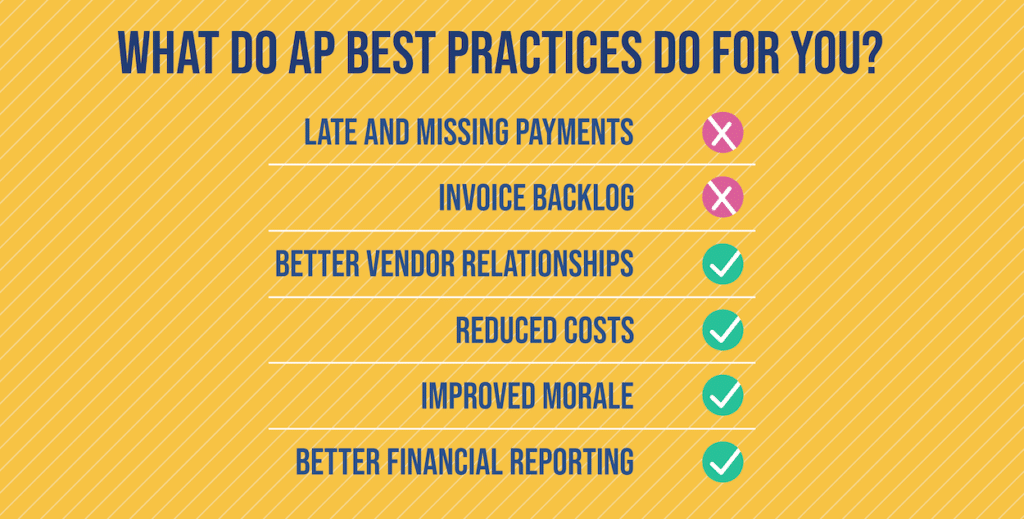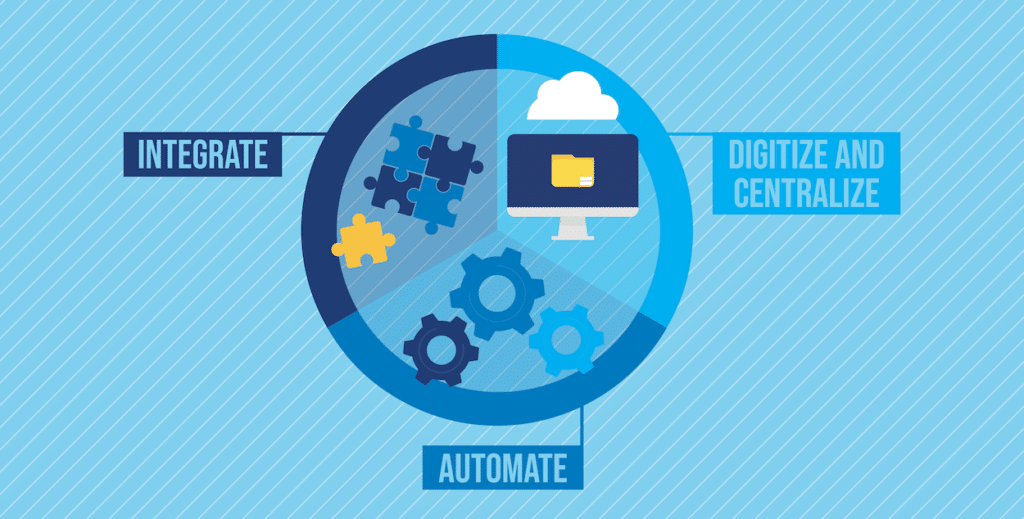The Definitive Guide to Accounts Payable Best Practices

Accounts payable (AP) has control over a business’s balance sheet, but AP is too often overlooked as businesses grow which creates a lack of control and inability to support the business as it scales. By implementing accounts payable best practices from this guide, the AP function can be leveraged as a tool to support large-scale organizational goals such as strengthening internal controls, supporting growth, improving efficiency, and profitability.
In this blog post, we highlight the accounts payable best practices AP departments can use in the back-office to become a strategic partner to the executive team and a major asset to the business. All the while, ensuring controls are at pace to support growth no matter the business working environemnt.
6 Key Benefits—What You Get With Improved Accounts Payable Processes
Streamlined accounts payable processes and workflows can have drastic effects for your organization both at the individual level (employee morale) all the way up to the corporate level (bottom line). These 6 key benefits from our accounts payable best practices guide will help you build a modern AP team, enable AP to complete administrative tasks in a more controlled and efficient manner from any location.

Best practices must be applied to a proposed solution once you’ve identified your root issues inside accounts payable.
Once you set a target toward some (or all!) of the AP benefits in this section, you can use that as a North Star to pick and choose which best practices to prioritize, implement, and measure. That said, let’s quickly look at some of the benefits you should be looking to enjoy through optimization of your AP processes and workflows.
Reduce missing and late payments
There’s nothing that can ruin your Friday afternoon than a coworker rushing into your office with a vendor on the phone demanding to know where payment is for an invoice that’s 30 days overdue. You can both play the blame game as you start digging through paper files, emails, and chat histories trying to find where the invoice got lost, but the vendor won’t care.
Missing or late payments, especially if it becomes a habit, can:
- Ruin your reputation with vendors
- Create extra costs through late payment fees
- Damage the organization’s credit
- Cause undue stress on employees with the added context switching
Therefore it goes without saying that always paying all your bills on time is an AP best practice. Ensuring your vendor invoices are processed and paid on time can be done by deploying technology to keep track of upcoming invoice due dates, specifically, accounts payable automation software.
Related reading: Accounts Payable Risk Assessment: 8 Questions to Uncover Threats
Reduce invoice backlog
In addition to the risk of late or missing payments, your organization will never grow to its full potential if you have a backlog of invoices.
When Purple, the Utah-based company that kickstarted the mattress revolution in 2013 needed a way to reduce the massive invoice backlog they’d accumulated for their 1,350 vendors, they implemented an AP Automation platform. With AP Automation, Purple reduced the time to process invoices from eight days to three days. This allowed them to charge through their backlog of invoices without immediately hiring additional AP staff.
Reduced cost per invoice
There’s nothing an executive team likes more than not seeing the AP department’s OpEx budget increase substantially due to inefficiency. One of the key indicators of efficiency within an accounts payable system is the cost per invoice. The average cost of processing a paper invoice can be upwards of $30, but with AP Automation tools, you can reduce that substantially. Leveraging automation in accounts payable is the best practice to reducing the cost to process an invoice.
Improved employee morale
In a worst-case scenario, AP staff face a lot of barriers with their day-to-day responsibilities when AP processes are manual. Confused coworkers wondering why their vendors haven’t been paid, a stack of paper invoices to process, and an afternoon full of manual data entry and chasing down invoice approvals.
On the other hand, when you enable your staff by providing them with the right technology to eliminate their mundane and tedious tasks, you empower them to think strategically and focus more on tasks that add value to the business.
More control, enhanced reporting & visibility
Accounts payable can’t be an asset to CFOs, Controllers, and the executive team if the function can’t help answer the following questions:
- Who processed this invoice?
- Who approved this invoice?
- Which invoices have not been paid yet?
- What’s the average cost and time to process an invoice?
- What’s our cash position?
If your AP stats are more like a black box of tangled data points than an intuitive dashboard with access to real-time info, enhancing visibility should be a top priority. Thus, it’s a best practice to improve visibility and control by leveraging accounts payable technologies that automatically provide reports and easy access to information for invoice or payment related questions.
Related Reading: A Complete Accounts Payable Internal Controls Checklist
Ability to scale
Last but certainly not least, perhaps the most important AP best practice to implement is to make sure that the system you’re using has the ability to scale. And by “scale” we don’t mean adding more full-time employees or paying overtime to work through your backlog—we mean a series of workflows and processes that can handle a larger volume of invoices without increasing the time or effort it takes to process them.
This too can be done with AP Automation software which streamlines invoice intake, coding, routing for approval and much more with the help of artificial intelligence. For example, Billy the Bot, is the engine behind the Stampli platform and has been helping accounts payable teams scale as invoice volume increases.
Accounts Payable Best Practices — 3 Steps to Improve AP Processes

1. Digitize and centralize
If you’re looking to implement accounts payable best practices so that you can enjoy the benefits described above, there’s no getting around it—you must digitize your AP processes.
Paper invoices have to go, or scanned at minimum. There are many benefits for both you and your vendors to switch to digital invoices, but if you’re having trouble convincing them to make the switch, check out this article for some tips about how to encourage them to go digital. Not just invoices, of course—this goes for purchase orders and other supporting documentation as well.
Once you go digital, a wonderful world of AP best practices opens up for you—you can capture invoice data automatically, you can cross-reference info, and you can massively improve your file management operations since all documentation is only a quick keyword search away.
But just digitizing isn’t enough. In addition to getting all your invoices into the computer, you also need to centralize your financial data. Once everything is digitized and housed in the same system (or ecosystem if you have integrations) you can start to enjoy some additional benefits such as:
- Communicate on top of an invoice with stakeholders and ability to keep track of conversations or invoice actions
- Audit-ready backups of all your invoice and payment information
- Automated workflows and actions (more on that in the next sections)
- A ‘single source of truth’ via management dashboards to increase reporting accuracy and capabilities backed by real-time data
2. Automate
This is where things start to get really fun, and you know why? AP Automation eliminates menial repetitive tasks which take time away from accounts payable. When it comes to accounts payable invoice processing, we’re talking about data entry, three-way matching, chasing down approvals. With AP Automation, anything that a computer can do better than a human is done by a computer.
Here are a few examples:
- Data entry: Leading AP Automation platforms have the ability to read invoices, capture the data (line items, not just the header), and help route it to the appropriate approver(s).
- General ledger coding: You can easily program an AP Automation platform to automatically code invoices against your general ledger for accurate reporting.
- Three-way matching: Using data from the invoice, the purchase order, the receipt, or any other supporting documentation, software can match up and link corresponding documents so all the backup is in one place.
- Approval notifications: If the invoice is verified, why not have the system automatically identify the invoice approver or approvers (and in the correct order) who will need to sign off?
- Send to payment processor: And if the invoice is approved and ready for payment, why not process payment through the system via ACH, check, or have it automatically sent to your financial system for your desired payment method.
- Tax and regulatory compliance: Leverage the AP Automation system to help you manage your Vendor Files from contracts, MSAs, W-9s, insurance information, and other vendor-specific files can be made available with invoices sent by the vendor for faster approvals and to ensure regulatory compliance.
- Archival: Once the dust settles, tuck all those files away for safekeeping in a secure, cloud-based database. In an AP Automation platform, these records are kept for 7 years and are easily searchable via the system.
In addition to the massive time and cost savings AP Automation provides, it also provides a deeper level of efficiency that can be measured—set a KPI for cost per invoice, implement AP Automation, then measure the results.
3. Integrate
The final accounts payable best practice we’re going to outline is the practice of integrating the best tools for the job. Stampli, for instance, is amazing for invoice processing and management, but it’s not an ERP. Therefore, why not just get the best of both worlds and integrate your invoice management software and your ERP? For a list of Stampli’s current integration partners, check out our accounts payable software integrations page.
The same goes for your accounting applications and performance management software. As opposed to being boxed into a certain way of doing things based on limitations of software that does most of what you want, be willing to buy exactly what you want (run your system your way) and integrate with the tools and processes your organization is familiar with, similar to QuickBooks accounts payable automation.
And when it comes to AP Automation out for “do-it-all” solutions, be wary and note if they are invoice management or payments first. If they are payments first, they might try to lock your entire organization into an invoice approval software and force you to use their methods of payment. You can read more about the three different types of accounts payable vendors in this blog post: What You Need to Know About AP Automation Vendors.
There are massive benefits afforded to those companies who use AP Automation technology that is payment agnostic, but in order to realize them you need total transparency and seamless integration between disparate applications.
Technological advances now allow AP departments to become strategic partners in the businesses they used to support solely in the ‘back office’ function.
Ready to implement the accounts payable best practices possible with AP Automation? Talk to an AP expert today to find out how Stampi can help.